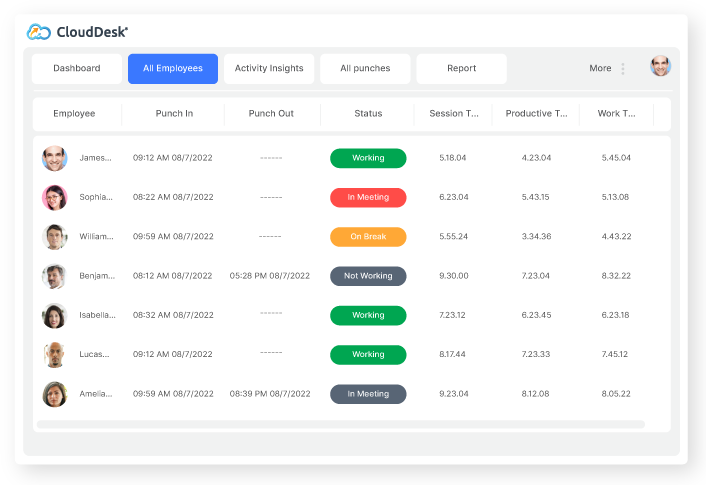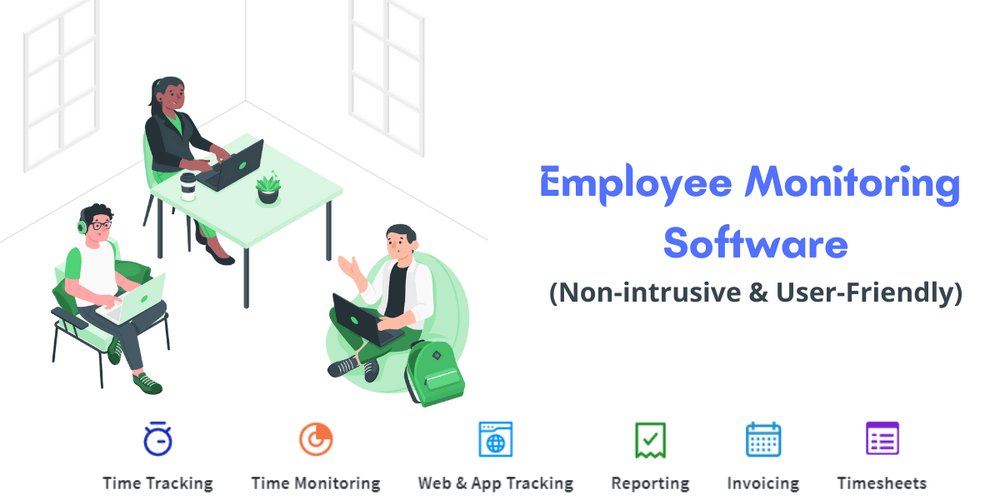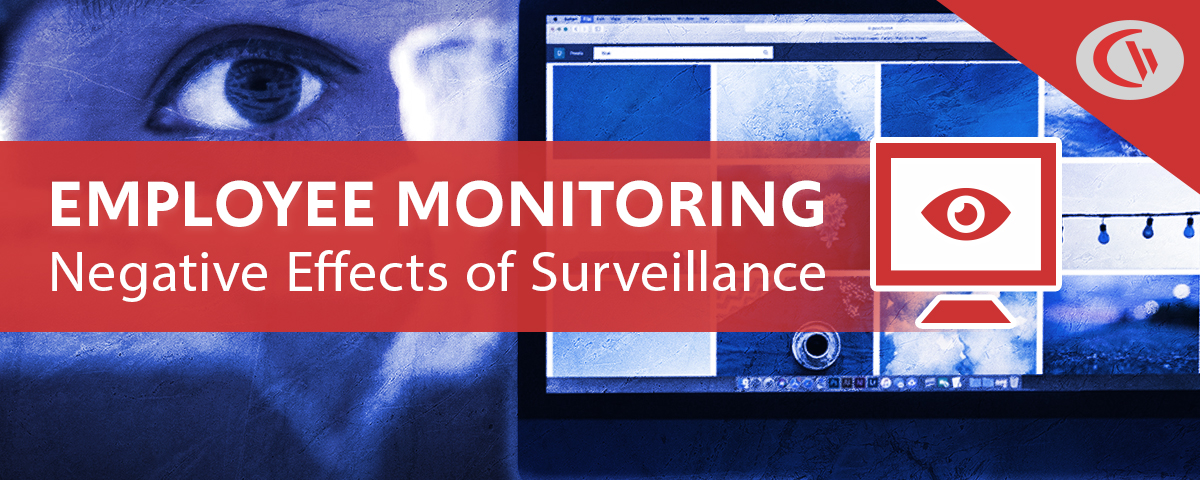The term employee monitoring software is used to refer to the software that companies employ to track their employees' activities while they work. Employers are able to collect information about a range of factors related to employee behavior. This includes internet usage and application usage, keystrokes and screenshots. Software designed to monitor employee behavior is mostly used to increase productivity, ensure the compliance with corporate policies, protect sensitive data as well as address security concerns. When selecting an employee monitoring software, there are a variety of things to think about. Here are some important points to remember: Features- Determine the specific features you need based on the needs of your business. Features that are common include activities monitoring (including blocking websites), keystroke logs (including application usage tracking), email monitoring, and reporting. Make sure you prioritize features that are in line with your goals for monitoring.
Privacy and Compliance: Make sure the software is compliant with all ethical and legal guidelines for monitoring employees. Make sure you are familiar with any applicable laws or laws, such as the privacy laws and regulations. Find software that offers transparent and configurable settings to respect employee privacy rights.
User-Friendliness- Think about the software's simplicity of use and accessibility. Easy setup and a user-friendly interface will make the installation easier and help you save time. Customizable dashboards and intuitive tools for reporting can help you easily navigate the data.
Integration and Compatibility - Make sure that the software you choose to use is compatible with the IT infrastructure that you are using and the systems you are using, including email clients, collaboration platforms, project management tools, and operating systems. Its compatibility allows for seamless monitoring without disrupting day-to-day operations.
Data Security- Evaluate the security measures of the software to safeguard the collected data. Access controls, encryption, secure storage of data and compliance with industry standard security protocols are vital. Be sure that the software provider is known for its strong data protection record and has robust security measures.
Scalability- You should think about the software's scalability to accommodate the expansion of your business. If you are planning to expand your staff or adding new locations, you should choose a software that can easily scale to accommodate your changing needs.
Reporting and Analytics - Look at the features of the software that allow reporting. Features that offer comprehensive insight into employee productivity, time management, and trends are essential to search for. Customized reports and analytics can assist you in making educated decisions, and identify areas to improve.
Customer Support- Evaluate the quality of customer service offered by the software vendor. Evaluate their responsiveness, availability and level of technical support. A good customer service will provide prompt assistance when problems arise.
Cost- Think about the pricing model for the program, whether it's a one-time fee, subscription-based, or usage-based. Know the pricing structure, including any added costs for support upgrades and other features. Consider the cost and features of each product.
Transparency and communication with employees- Be transparent and communicate clearly to employees about the deployment and use of software for monitoring. Define the scope and function of the monitoring in a clear manner. Address any concerns they may have and ensure they understand the ways in which their privacy will be respected.
These elements will help you make a more informed choice about the employee monitoring software you choose. Have a look at the top rated time tracking monitoring service company for blog advice.

What Are The Features Of Employee Monitoring Software And How Can They Differ?
The software provides a variety of features that allow you to track and analyze the activity of your employees. The specific features can differ among different software options, but here are some typical features that are found in all employee monitoring software- Activity MonitoringThe feature tracks and records employee actions, including sites visited, apps used, files accessed, and time spent in each job. It provides an in-depth description of how employees utilize their time.
Keystroke logging- Keystroke logging records all keystrokes typed by employees. It can be used for identifying productivity bottlenecks, detecting unauthorised activities, and gathering evidence in the event of an investigation.
Screenshots or Screen Recording - Some software takes regular screenshots from computer screens, whereas others record their screens live. This feature is useful for monitoring employee performance, checking compliance, or troubleshooting issues.
Internet Usage Tracking- This feature monitors employees' internet activities, which include the websites they visit, searches as well as downloads. It assists in identifying excessive non-work-related browsing, possible security risks or policy violations.
This feature tracks all apps used by employees at work. It helps to identify unapproved and excessive application usage by providing information about the apps that are used most often.
Email Monitoring - This feature gives employers the capability to track employee email, which includes messages received and sent attachments, emails and other content. It can help ensure the compliance of company policies to prevent data leaks and investigate any suspicious activities.
File and document tracking This feature monitors changes in the form of transfers, modifications, and additions to documents. It protects sensitive data as well as monitor document collaboration and ensure compliance with data security guidelines.
Remote Monitoring allows employers to supervise employees who work remotely or at various locations. Employers are able to monitor their activity and ensure that they work efficiently regardless of where they are.
Productivity Analysis – Employee monitoring software has tools for analysis of productivity that reveal patterns in employee of work, time allotment and productivity levels. These analyses assist in identifying areas to improve and enhance workflow.
Analysis and Reporting- Robust analytics and reporting tools provide detailed reports and graphs based upon the collected data. These reports offer valuable insight into the performance of employees, resource allocation, and time management.
Compliance and Policy Management- Some software solutions provide features that ensure compliance with industry regulations and company guidelines. Employers are able to establish and enforce policies pertaining to acceptable computer use, internet access, and data security.
Alerts and Notifications: Alerts and notifications inform employers or managers when specific situations or events occur. You can use them to warn you of unusual behavior, like excessive use of the internet or attempts to gain access to restricted websites.
The availability and functionality of the features can vary between different options for employee surveillance software. Consider features that will assist you in reaching your goals for monitoring as well as ensuring compliance with ethical and legal standards of your jurisdiction. Take a look at the top rated time tracking monitoring services for more recommendations.

What Is The Best Software For Monitoring Employees? Comply With The Compliance And Privacy Law?
It is crucial that the software used for monitoring employees conforms to compliance and privacy laws. While the specific legal requirements may vary by jurisdiction, here are some typical ways that employee monitoring software adheres to compliance and privacy laws- Consent and Notice- Many areas require employees to provide their informed consent, and get prior notice of any monitoring activity. Monitoring programs for employees typically include features that enable employers to clearly communicate monitoring policies with employees. It is possible to provide written notices or obtain consent through consent forms. Additionally an employee handbook that outlines monitoring policies can also be implemented.
Transparent Monitoring Policies- Employee monitoring software promotes transparency by making sure that employees are aware of the specific kinds of data that are collected, the purpose of monitoring, and the extent of monitoring activities. Clear and comprehensive policies allow employees to know the limits and rights of privacy and monitoring.
Data Minimization Principles - Employee monitoring software typically employs methods to reduce data in order to comply with privacy laws. That is, only data that is necessary is stored and collected. Data that is not needed or excessive is not required to be gathered. By limiting the collection of data to only what is required to monitor The software minimizes the risk of privacy and increases compliance.
Anonymization and Aggregation- Some software that monitors employees anonymizes or aggregates data to protect employee privacy further. Data gathered is anonymized to remove personal information that can be identified as being personally identifiable. The data of several employees is combined to give insights on a group-level without identifying individual.
Secure Data Storage and encryption The security of collected data is an important concern for monitoring software designed to monitor employees. It generally utilizes secure storage practices for data as well as encryption methods to protect data from unauthorized access, breaches or disclosures that are accidental. Secure data is important when it is in transit and in the rest of the data.
Access Controls and Restricted Permissions For compliance purposes, employee monitoring software typically provides granular access controls and permissions. This allows employers to limit access to monitoring data only to those who are authorized to use it for legitimate reasons like HR employees or administrators designated by the company.
Employee RightsRespecting the rights of employees is adhering to compliance and privacy laws. Software for monitoring employees usually has features that permit employees to access and correct their own monitoring data and also file complaints. It allows employees to assert their rights and pursue remedies in cases of privacy breaches.
Conformity to Data Protection Regulations – The employee monitoring software has been designed to conform with applicable data protection laws, such as General Data Protection Regulations in Europe or California Consumer Privacy Acts in the United States. To ensure compliance, companies must implement the required measures to protect the rights of data subjects and ensure lawful processing.
While employee monitoring can help organizations meet the requirements of laws and regulations, they must also consult lawyers and keep up to date on local laws and regulations. In order to comply with privacy and compliance regulations requires a thorough approach that goes beyond the software, and includes explicit policies, education for employees, and ongoing compliance monitoring. See the top rated time tracking monitoring software for website tips.
